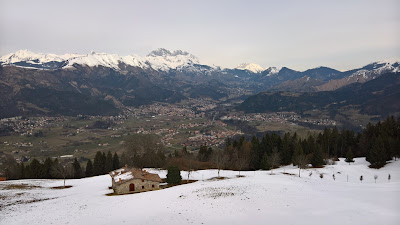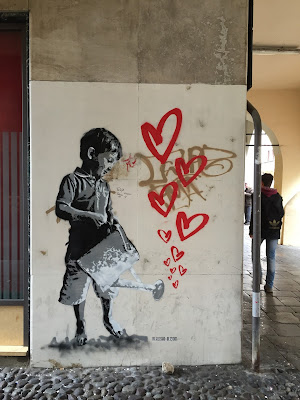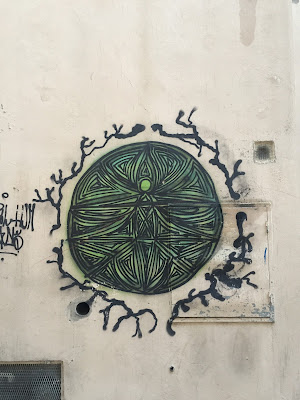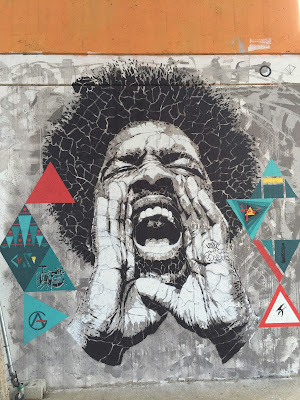Left: View from Rifugio San Lucio toward the Presolana mountain range.Right: Clusone clocktower - Torre dell'orologio.

Clusone is a curious town about 35 km northeast of Bergamo, in the
Val Seriana, where you can see one heck of an impressive clock, get a lesson in the universality of death, and then take a hike. On this sunny Saturday, we walked through the old town to see the Palazzo Fogaccia and the fantastical Torre dell'orologio, the main church of
Santa Maria Assunta, and the
danse macabre mural outside of the
Oratorio dei Disciplini, and then headed to the hills for lunch at a rifugio.
We hardly saw everything the town has to offer, but wevwere struck by the things we did see. First, there is the Fanzago planetary clock (
Orologio planetario Fanzago) built in 1538 and still functioning today on Palazzo Fogaccia. It has been wound by hand for over 450 years each day!
After puzzling over the clock, we moved on to the main church, with a terrace that provides a beautiful view facing south. Often church interiors don’t engage us for more than a few minutes, but the interior of Santa Maria Assunta impressed us with its simple layout and well-appointed side altars. One altar we thought particularly interesting was the
Altare dei morti which features a skeleton reclining with a scythe and hourglass. His boney hand holds a piece of paper that reads
hodie mihi, cras tibi (“today it’s me, tomorrow will be you”), done in
pietre dura. Nearby, outside the church, the Oratorio mural
Il trionfo della morte is another reminder about the universality of death. Okay, enough of this death stuff because we’ve got a lunch reservation at the Rifugio San Lucio and a 4 km walk to get there.
To get to Clusone from Bergamo, we took the
TEB tram to Albino and then a
SAB Transport bus further up into the valley. The night before we went, I spent several hours trying to understand the transport systems serving Bergamo. I finally threw up my hands and went on a rant about the byzantine nature of it all. The best advice I can give is if you are unsure of a trip from Bergamo out to places beyond the urban center, then get your tickets the day before. For trains, regional buses, and tram tickets, go to Bergamo central station. For buses within the Bergamo urban area, go to the ATB office in Largo Porto Nuovo, 16. Additionally, you can go to any
tabaccheria that sells transport tickets and explain what you want to do and let them figure out which tickets you need. And remember, always get your tickets validated when you board a bus or tram. For the two of us, it cost about € 25 roundtrip Bergamo – Clusone roundtrip.
After a quick look around Clusone’s old center, we headed south from the clock tower toward the
Rifugio San Lucio. We reached the rifugio on foot in about two hours, walking south on via S. Lucio. (Transportation may seem opaque to me, but street names in Italy make so much sense.) As via San Lucio starts to climb the hill, there is a parking lot and a sign indicating a steep trail also going to the rifugio if you don’t want to walk the road.
If you take the trail, you’ll see there are two ways up. One way is to follow the signs for “Zuccone” or “Roccolo Zuccone,” which takes you past an area on the hill called Zuccone and a display of whimsical wood sculptures scattered all around. We took the Zuccone path back down, not up. It’s worth taking the path at least one way to see the sculptures.
The San Lucio rifugio is at 1,027 m and on this day, there is a moderate amount of snow around. After a satisfying lunch of
foiade and buckwheat
tagliatelle with hearty winter sauces and polenta with rabbit or braesola, we walked back down to the city center to investigate the
MAT – Museo Arte Tempo – Palazzo Marinoni Barca. If you are interested in time pieces, this small museum, with free entry, is worth a visit. Interesting mechanisms for keeping time are scattered throughout the temporary exhibit space (first floor) and the permanent collection (second floor). On the first floor, there was also a display of photos (
scatti) from a local studio,
La Bottega Cristalli, covering people and events in Clusone from the 1920s to the 1970s. In the permanent collection, there are works by prominent artists born in Clusone including the painter Giovanni Trussardi Volpi (1875 – 1921) and the sculptor Attilio Nani (1901 – 1959).
During our hike, we saw
Bergamasca sheep (originally from the valleys around Bergamo) and
Highland cattle (originally from Scotland). The sheep stared at us half-asleep, and the cattle bells rang hypnotically across the valley. The pastoral scenes coupled with everything else we had seen today,
memento mori, a planetary clock still working after 450 years, and whimsical wood sculptures scattered throughout the forest, made me forget about my transportation rantings -- at least for now.
Left: Altare dei morti in Clusone Santa Maria Assunta. Right: The mural Il trionfo della morte, Oratorio.































































![Helleborus niger [Ranunculaceae] – Christmas Rose Helleborus niger [Ranunculaceae] – Christmas Rose](https://blogger.googleusercontent.com/img/b/R29vZ2xl/AVvXsEjjorvtg-U6o8EftD7bpb6fIRDD4cyssPks1h_t_4ZnxV7Oh240YKFIatkSEtRd95Ko7kbBxeQs-vtNFu9MlhdexvxBZzuQ4FevNoKj2h1ySku8tvKi28ouKkDy41-pftuIYaD67CBk5Q/s400/Helleborus+niger+%255BRanunculaceae%255D+Christmas+Rose+2.jpg)
![Helleborus niger [Ranunculaceae] – Christmas Rose Helleborus niger [Ranunculaceae] – Christmas Rose](https://blogger.googleusercontent.com/img/b/R29vZ2xl/AVvXsEixcCDgY4_irmVITXwBjSlciH27nksvW2UcM0UyDM4luHpXo1KT0bl3CiAFXaSBjYvf1zbaS7rowDSj7eaaAc0sTi_hRAI0PWPeef9m9hSSXOCoJW6-rOVQU8wv0JML_kIzLGvuwaIipg/s400/Helleborus+niger+%255BRanunculaceae%255D+Christmas+Rose.jpg)



